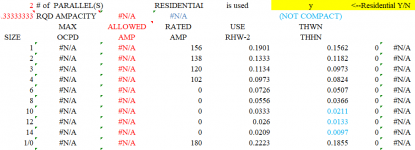I believe the largest possible current in the neutral with balanced L-N nonlinear loads would be √3 ≈ 1.73 or 173% of the line current. That would happen if there is no overlap of the three L-N current waveforms at any point during a cycle. As mentioned, this would be an unusual situation. I think they round up the 173% to 200% just for convenience.
When using 200% neutrals because of high harmonic loads, is the best way to achieve the 200% neutral:
1. Parallel neutrals the same size as the phase conductors, or
2. A single neutral with two times the cmil area of the phase conductors?
I believe this would depend on the specific situation.
In general, the ampacity does not double when the cmil is doubled. For example, 4/0 has twice the circular mils as 1/0. But the ampacity in table 310.16 for THHN is 205A for 4/0 and 135A for 1/0, or a factor of 205/135 = 1.52 more, not the 2X more with parallel conductors.
On the other hand, having two parallel neutrals instead of one larger neutral will add one more current carrying conductor. If that pushes you into a lower derating factor for all of the conductors in a raceway then that would have to be considered.


